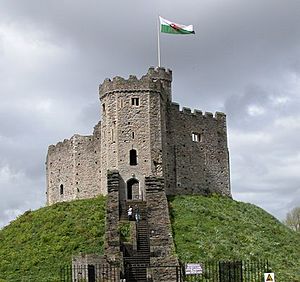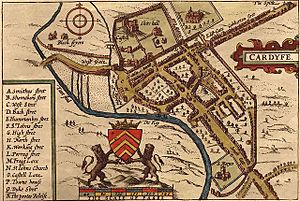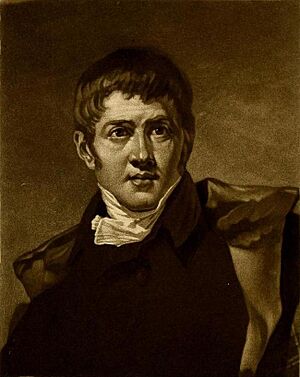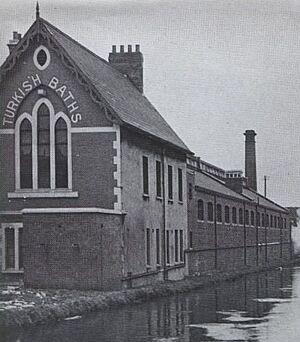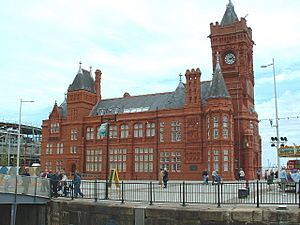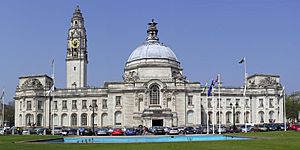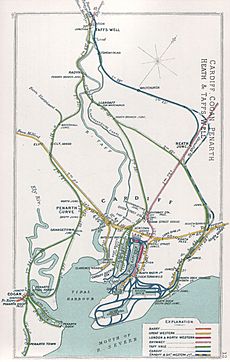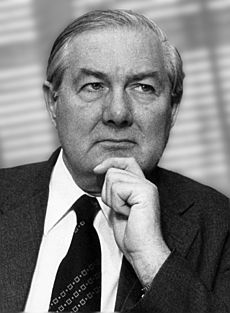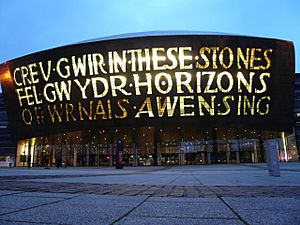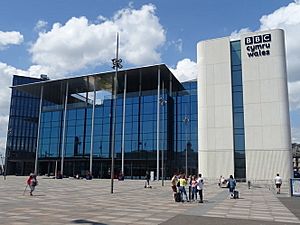Timeline of Cardiff history facts for kids
The history of Cardiff is a story of how a small Roman fort grew into the modern capital city of Wales. This timeline shows the important events that shaped Cardiff over many centuries.
The name Caerdyf comes from old Welsh words. It means "the fort on the Taff". The "fort" likely refers to the one built by the Romans. Caer is Welsh for fort, and -dyf is a form of Taf, the river that flows through Cardiff.
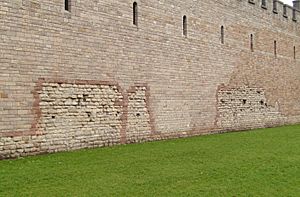
Contents
Cardiff's Roman Beginnings
50s AD: The Romans set up a settlement here.
75: A Roman fort was built where Cardiff Castle stands today.
380s: The Romans left Cardiff.
Viking Visitors and Settlers
850: Viking raiders attacked the Welsh coast. They used Cardiff as a base and a port. Some street names, like Dumballs Road and Womanby Street, come from the Vikings.
The Norman Town Takes Shape
1081: William the Conqueror led his army through southern Wales. He might have built defenses at Cardiff on the old Roman fort site.
1100: A small town started to grow outside the castle. It was mostly settled by Norman and Saxon people.
1111: The Cardiff town walls were first mentioned in a book called Brut y Tywysogion.
1126: Ralph "Prepositus de Kardi" became the first Mayor of Cardiff.
1158: Ifor Bach, a local Welsh lord, attacked Cardiff Castle. He captured William of Gloucester, the Lord of Glamorgan.
1180: St John the Baptist Church was built.
1294: Welsh people from Glamorgan attacked Cardiff Castle.
1315: Llywelyn Bren, a relative of Ifor Bach, also attacked Cardiff Castle.
1318: Llywelyn Bren was put to death in Cardiff.
1324: A special document from King Edward II showed that Cardiff was an important place for trade and shipping.
1327: Cardiff was named a Staple Port. This meant certain goods had to be sold there.
1340: Hugh le Despenser gave Cardiff an important early charter. A charter is a document granting rights.
1404: Owain Glyndŵr, a Welsh leader, captured Cardiff Castle.
Cardiff Becomes a County Town
1536: England and Wales officially joined together. Glamorgan became a shire (a county), and Cardiff was made its county town. The Herbert family became very powerful in Cardiff.
1542: Cardiff became a free borough. This gave its citizens more rights.
1551: William Herbert became the first Baron Cardiff.
1574: Henry Herbert started to restore Cardiff Castle.
1595: The first shipment of coal was sent out from Cardiff docks.
1608: King James I gave Cardiff a Royal Charter. This was a special document that gave the town more rights and power.
1610: John Speed created a map of Cardiff.
1645: King Charles I visited Cardiff after a major battle.
1648: The Battle of St. Fagans took place near Cardiff. It was the last big battle in Wales. The Parliamentarian Army defeated the Royalists.
1737: Flat Holm Lighthouse was built.
1766: John Stuart, 1st Marquess of Bute married into the Herbert family. They owned a lot of land locally.
1774: A law was passed to create "Improvement Commissioners." They were in charge of paving streets, cleaning them, and providing oil lamps for lighting in Cardiff.
1776: John Stuart was given the title Baron Cardiff of Cardiff Castle.
1778: The rebuilding of Cardiff Castle began.
Cardiff's Big Growth in the 1800s
1793: John Crichton-Stuart, 2nd Marquess of Bute, was born. He is known as the person who created modern Cardiff by building its port.
1794: The Glamorganshire Canal opened. It connected Merthyr Tydfil to the sea at Cardiff.
1801: Cardiff's population was 1,870 people.
1815: A boat service started between Cardiff and Bristol. It ran twice a week.
1819: Cardiff Free School opened for boys and girls.
1821: Cardiff Gas Works was set up to provide gas.
1826: The first theatre in Cardiff, the Theatre Royal, opened.
1831: The population grew to 6,187.
1832: A new county prison was built.
1835: Elections were held for Cardiff's new Borough Council.
1836: The first meeting of Cardiff's Borough Council took place. Thomas Revel Guest became the first elected Mayor.
1839: West Bute Dock opened. This was a major step for shipping coal.
1840: The first railway station opened in Cardiff. It was owned by the Taff Vale Railway. The service ran from Cardiff to Navigation House.
1850: The Cardiff Water Company was created to supply water to the town.
1853: The new Town Hall opened.
1855: The Taff Vale Railway started a train service from the Rhondda Valley to Cardiff.
1857: The last public execution in Cardiff was held.
1857: The Cardiff Times newspaper began to be published.
1858: The Rhymney Railway opened a main line with some passenger service.
1859: A new stone bridge, Cardiff Bridge, was built.
1860: The Principality Building Society was started.
1861: The population reached 32,954.
1862: The Guildford Crescent Baths opened. They had two swimming pools and a Victorian Turkish bath.
1863: The Royal Arcade opened. It was the first of many shopping arcades in Cardiff.
1865: James Howell started Howells department store.
1867: Cardiff Cricket Club was formed. Their ground was Cardiff Arms Park.
1867: The Western Mail newspaper was founded.
1872: The Clock Tower at Cardiff Castle was finished.
1873: The Swiss Bridge, Cardiff Castle was built for the 3rd Marquess of Bute.
1876: Cardiff Arms Park hosted its first rugby game between Cardiff Rugby Club and Swansea Rugby Club.
1879: Cardiff Town Council took over the water supply.
1881: The first grandstand was built at Cardiff Arms Park. It could hold 300 people.
1882: The new Cardiff Free Library, Museum and Schools for Science and Art opened.
1883: The current Cardiff Royal Infirmary building opened.
1883: The National Eisteddfod, a Welsh cultural festival, was held in Cardiff.
1883: Aberdare Hall, a university hall of residence, was established.
1884: Cardiff Arms Park hosted its first international rugby match between Wales and Ireland.
1885/6: Frank Hancock of Cardiff RFC introduced a new "two-centre" rugby tactic. This idea was later used worldwide.
1886: The Coal Exchange opened. This was a place for trading coal for the growing industry.
1889: Cardiff became a county borough. This meant Cardiff County Borough Council was independent from the Glamorgan County Council.
1893: Ivor Novello, a famous composer, was born in Cardiff.
1893: University College of South Wales and Monmouthshire became part of the University of Wales.
1895: The first Welsh Grand National horse race was run at Ely Racecourse.
1897: The Pierhead Building was built.
1899: Riverside Football Club was formed. It later changed its name to Cardiff City.
1901: The population reached 164,333.
1903: The first building in Cathays Park, the University of Wales, Registry, opened.
1904: Cardiff Town Hall opened. It was later renamed City Hall.
Cardiff Becomes a City and a Coal Giant
1905: King Edward VII officially made Cardiff a city. The Mayor became the Lord Mayor.
1907: Queen Alexandra Dock opened. It was the largest dock in Cardiff.
1909: The University building in Cathays Park opened. The first Clark's Pies were made.
1910: Cardiff City played their first match at Ninian Park.
1912: National Museum Cardiff was established. It opened to the public in 1922.
1913: A record 10.7 million tons of coal were sent out through Cardiff docks. This was the busiest time for the docks.
The Docks Decline and New Beginnings
1916: Roald Dahl, the famous writer, was born in Llandaff, Cardiff.
1919: Four days of race riots happened in June, leading to three deaths.
1923: The BBC started broadcasting from studios in Castle Street.
1927: Cardiff City beat Arsenal 1–0 to win the FA Cup.
1931: Cardiff Municipal Airport opened on Pengam Moors.
1932: The first miners' hunger march to London started from Cardiff. They were protesting about unemployment.
1935: The first RAC Welsh Rally began in Cardiff.
1937: Shirley Bassey, the famous singer, was born in Tiger Bay, Cardiff.
1941: The heaviest German Luftwaffe air raid of World War II hit Cardiff. It was called the Cardiff Blitz. 156 people were killed.
1946: Welsh National Opera performed its first shows.
1947: The Bute family gave Cardiff Castle to the city.
1948: The Welsh Folk Museum opened at St. Fagans.
1954: Cardiff Airport moved to its current location in Rhoose.
1955: Cardiff was officially recognized as the capital city of Wales.
1956: Cardiff stopped being a fishing port after 70 years.
1958: The British Empire and Commonwealth Games opened at Cardiff Arms Park. The Wales Empire Pool also opened for the Games.
1959: The movie Tiger Bay, partly filmed in Cardiff, was released.
1961: Public houses (pubs) in Cardiff were allowed to open on Sundays for the first time since the 1880s.
1963: The Rover car factory opened.
1964: West Bute Dock closed. The last coal shipment of 229,000 tons left the docks.
1966: The Heath Hospital officially opened.
1967: Glamorgan County Cricket Club played its first game at Sophia Gardens.
1970: Bute East Dock closed. Pearl Assurance House, the tallest building in Wales, opened.
1971: The National Sports Centre for Wales opened in Sophia Gardens.
1974: South Glamorgan was created as part of a local government change. Cardiff lost its independent County Borough status.
1976: James Callaghan, the Member of Parliament for Cardiff, became Prime Minister of the United Kingdom.
1977: The Welsh Industrial and Maritime Museum opened in Cardiff Bay.
1980: The M4 motorway to the north of the city opened.
1982: S4C, the Welsh-language television channel, was established. The Ely Link Road opened.
1983: The BBC Cardiff Singer of the World competition began.
1984: The National Stadium at Cardiff Arms Park opened.
1986: Wales National Ice Rink opened. The Cardiff Devils ice hockey team was formed.
Cardiff Bay and City Regeneration
1987: The Cardiff Bay Development Corporation was set up. Its goal was to transform the old, unused Cardiff docks into Cardiff Bay.
1988: The new County Hall was finished in Cardiff Bay. The Grangetown Link Road opened.
1989: Cardiff Athletics Stadium opened in Leckwith.
1995: The Butetown Link Road opened.
1996: Cardiff became a unitary authority. This meant Cardiff became an administratively independent city again.
1997: Wales voted to create a Welsh Assembly. Cardiff itself voted against it.
1999: The Millennium Stadium opened. It hosted the final of the 1999 Rugby World Cup. The Cardiff Bay Barrage also opened.
2001: The 2001 Census showed Cardiff's population was 305,353.
2004: The Wales Millennium Centre opened.
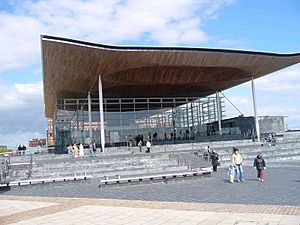
2006: The Senedd, the new debating chamber for the Welsh Assembly, opened.
2008: Cardiff International Pool opened in Cardiff Bay. It replaced the Wales Empire Pool. The National Eisteddfod was held in Cardiff again.
2009: Cardiff City Stadium and Cardiff International Sports Stadium both opened. Ninian Park was taken down as part of the Leckwith development. The new Central Library opened in March.
2010: Cardiff International White Water, a whitewater rafting center, opened at the International Sports Village.
2011: Wales voted to give the Welsh Assembly more lawmaking powers. This time, Cardiff also voted "yes," with over 61% supporting the change. The 2011 Census showed Cardiff's population was 346,100, its highest recorded number.
2013: Cardiff City was promoted to football's Premier League. This was 51 years after they were last in the top league. They were relegated at the end of the 2013–14 season.
2016: Ice Arena Wales opened to the public.
2017: The first part of the Eastern Bay Link Road opened. This road will eventually complete the Peripheral Distributor Road around Cardiff.
2019: The BBC's New Broadcasting House opened in Central Square.
2020: William Morgan House, a UK Government office building, opened.


